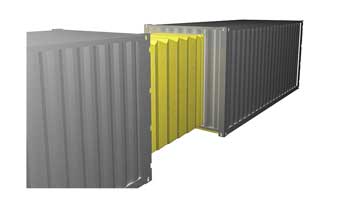
The abundance of natural disasters has created a strong demand for disaster relief modular
buildings. Connecting multiple buildings to create a campus is simplified by reapplying existing
innovation.
The recent abundance of hurricanes, earthquakes, and wildfires has created a strong demand for disaster relief modular buildings, like those made from shipping containers. Modular buildings are easily configured for multiple uses, including mobile hospitals, recovery command posts, and temporary lodging. Since rapid response is essential to relief efforts, overhead cranes or hydraulic lifting mechanisms may not be readily available to place multiple shelters in perfect alignment for direct connections. To mitigate uneven surface grading and inexact building placement, suppliers of portable buildings seek practical solutions to connect multiple shelters to form a mini-campus.
This is not a new challenge. Large, flexible bellows which connect mobile structures can be seen in passenger boarding and transit applications. Bus bellows are used to connect long articulated buses seen in major metropolitan areas. Folding type bellows are also seen on passenger boarding bridges (jet bridges) where an enclosed, movable connector extends to an airplane or ship. This proven technology responds to flexing while protecting occupants from sun, rain, wind, and snow. These applications already demand UV resistance and the capability to handle varying temperatures from -30˚F to 130˚F.
The same large bellows technology is used to connect multiple shelters together to make a campus, compound, or complex. In these applications, bellows reduce the number of doors exposed to the environment, helping manage climate control costs and acoustics. The bellows passageways also increase safety by eliminating stair navigation between buildings. When the application is food preparation or emergency medical services, the bellows help sustain clean and sterile environments. The reduced number of exposed doors also helps manage access to multiple buildings with sensitive or valuable contents.
Dynatect, formerly A&A Manufacturing, has supplied custom-engineered bellows for over 70 years, and has supplied bus and light rail bellows since the 1970s. Dynatect is using these same proven designs and materials to support companies in the modular building industry. Those companies use the custom passageway bellows to increase safety, save energy costs, maintain cleanliness, and manage acoustics in ways previously unachievable with standalone modules. These are especially applicable in fulfilling the unique needs of disaster response where modules cannot be precisely placed and need a passageway connection that compensates multi-axis misalignment.
Learn more by following the link: https://dynatect.com/product/protective-covers/bellows/passageway-connecting-bellows/